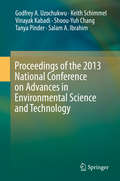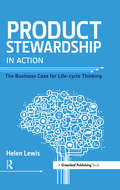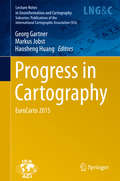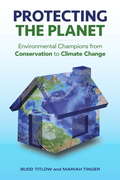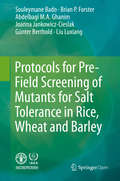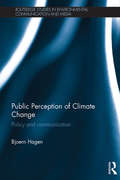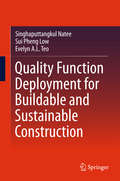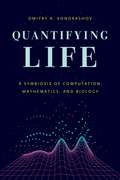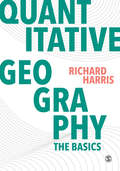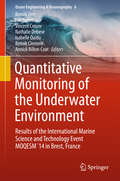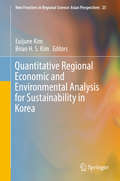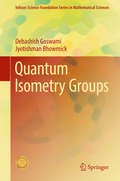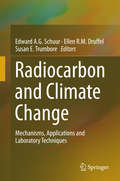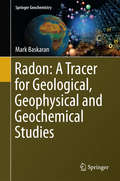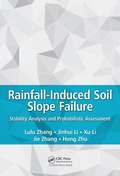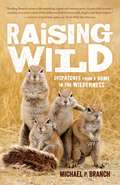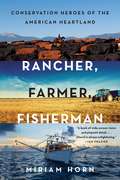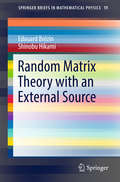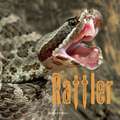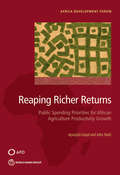- Table View
- List View
Proceedings of the 2013 National Conference on Advances in Environmental Science and Technology
by Vinayak Kabadi Shoou-Yuh Chang Keith Schimmel Godfrey A. Uzochukwu Tanya Pinder Salam A. IbrahimThis book contains peer reviewed papers accepted for presentation at the National Conference on Advances in Environmental Science & Technology. Topics include environmental regulations, groundwater remediation technologies, waste to energy, climate change, economics, environmental justice, fate and transport of contaminants, food bio-processing, innovative environmental technologies, sustainable energy and water resources and waste management. Federal agencies, private agencies and university professors set the stage for the September 12, 2013 National Conference on Advances in Environmental Science and Technology. The purpose of the National Conference on Advances in Environmental Science and Technology which was held in Greensboro, North Carolina, was to provide a forum for agencies to address advances in environmental science and technology including problems, solutions and research needs.
Product Stewardship in Action: The Business Case for Life-cycle Thinking
by Helen LewisProduct Stewardship in Action describes how and why leading companies are taking responsibility for the environmental impact of their products and packaging. Product stewardship, often referred to as "extended producer responsibility" or EPR, is the idea that everyone that benefits commercially from a product, including manufacturers, distributors and retailers, has a shared responsibility to minimize its environmental impacts. Written primarily for a business audience, it draws on the knowledge and experience of industry practitioners and other experts to provide a structured approach to product responsibility within firms. This will help those new to the field, as well as more experienced practitioners, to develop an effective response to stakeholder concerns about the environmental impacts of their products and packaging. Unlike other resources on product stewardship and EPR, which tend to focus on the design or evaluation of public policy, this book highlights the business case for action. It argues that companies can achieve "shared value" — both public and commercial value — when they take a proactive and knowledge-based approach to the life-cycle management of their products. Product Stewardship in Action focuses on product stewardship as an effective business strategy rather than a philanthropic exercise. To be effective it needs to be based on a good understanding of product impacts and stakeholder concerns, and the risks and opportunities that these present to the business. The most effective responses will be those that address material issues in the product life-cycle while supporting the achievement of other corporate goals and priorities.
Progress in Cartography
by Georg Gartner Haosheng Huang Markus JobstThis book gathers the latest developments in modern cartography, ranging from the innovative approaches being pursued at national mapping agencies and topographic mapping, to new trends in the fields of Atlas Cartography, Cartographic Modelling, Multimedia Cartography, Historical Cartography and Cartographic Education. Europe can look back on a long and outstanding history in the field of Cartography and Geoinformation Science. Its rich and leading role in the domain of cartography is proven by contributions from various countries and with a diverse range of backgrounds.
Protecting the Planet: Environmental Champions from Conservation to Climate Change
by Budd Titlow Mariah TingerClimate change is often associated with predictions of dire calamities. But in the past, heroic individuals have stepped forward to meet even the most ominous ecological challenges. This book tells an inspirational story--a story both of pioneering environmentalists who raised our collective consciousness regarding nature's value and heroes of today who are working to secure a sustainable future.The authors begin with the mounting evidence for climate change as seen in rising carbon dioxide levels, higher global temperatures, melting ice sheets, and sea level rise. They then review the history of the US environmental movement, focusing on the key people who changed our understanding of the human impact on our natural surroundings. These include John James Audubon, Henry David Thoreau, John Burroughs, Theodore Roosevelt, John Muir, Bob Marshall, Roger Tory Peterson, Aldo Leopold, Rachel Carson, David Brower, Barry Commoner, Donella Meadows, and many more. Turning to the present, the authors recount the activities of people currently pursuing remedies for climate change--scientists, researchers, activists, artists, and celebrities. Much of this information is based on recent personal interviews.They conclude with a set of actionable strategies, demonstrating that there are good reasons to hope that we can achieve a sustainable lifestyle, protect our planet as our home, and ensure the future for our children.From the Hardcover edition.
Protocols for Pre-Field Screening of Mutants for Salt Tolerance in Rice, Wheat and Barley
by Souleymane Bado Brian P. Forster Abdelbagi M. A. Ghanim Joanna Jankowicz-Cieslak Günter Berthold Liu LuxiangThis book offers effective, low-costand user-friendly protocols for the pre-field selection of salt-tolerant mutants in cereal crops. It presents simple methods for measuring soil salinity, includingsoil sampling and the analysis of water-soluble salts, and describes adetailed, but simple, screening test for salt tolerance in rice, wheat andbarley seedlings, which uses hydroponics. The protocols are devised for use byplant breeders and can be easily accommodated into breeding practice.
Public Perception of Climate Change: Policy and Communication (Routledge Studies in Environmental Communication and Media)
by Bjoern HagenDespite the findings on global climate change presented by the scientific community, there remains a significant gap between its recommendations and the actions of the public and policy makers. So far scientists and the media have failed to successfully communicate the urgency of the climate change situation in such a way that long-term, comprehensive, and legally binding policy commitments are being made on the national and international level. This book examines the way the public processes information, how they perceive threats and other perceptual factors that have a significant effect on how and to what degree climate change mitigation and adaptation strategies are supported. Understanding public risk perception plays a vital role in communicating the challenges of global climate change. Using a diverse range of international case studies, this book explores the nature of public perceptions of climate change and identifies the perception factors which have a significant impact on the public’s willingness to support global climate change policies or commit to behavioral changes to reduce greenhouse gas emissions and improve urban resiliency. The comparative study of social and cultural factors, beliefs, attitudes and trust provides an international overview of best practices regarding the design, implementation and generation of public support for climate change policies at a global level. Offering valuable insight into climate change and risk communication, the book should be of interest to students and scholars of environment studies, politics, urban planning, and media and cultural studies.
Quality Function Deployment for Buildable and Sustainable Construction
by Sui Pheng Low Singhaputtangkul Natee Evelyn A. L. TeoThis book focuses on the implementation of Quality FunctionDeployment (QFD) in the construction industry as a tool to help buildingdesigners arrive at optimal decisions for external envelope systems withsustainable and buildable design goals. In particular, the book integratesspecial features into the conventional QFD tool to enhance its performance. These features include a fuzzy multi-criteria decision-making method, fuzzyconsensus scheme, and Knowledge Management System (KMS). This integrationresults in a more robust decision support tool, known as the Knowledge-basedDecision Support System QFD (KBDSS-QFD) tool. As an example, the KBDSS-QFD toolis used for the assessment of building envelope materials and designs for high-riseresidential buildings in Singapore in the early design stage. The book providesthe reader with a conceptual framework for understanding the development of theKBDSS-QFD tool. The framework is presented in a generalized form in order tobenefit building professionals, decision makers, analysts, academics andresearchers, who can use the findings as guiding principles to achieve optimalsolutions and boost efficiency.
Quantifying Life: A Symbiosis of Computation, Mathematics, and Biology
by Dmitry A. KondrashovSince the time of Isaac Newton, physicists have used mathematics to describe the behavior of matter of all sizes, from subatomic particles to galaxies. In the past three decades, as advances in molecular biology have produced an avalanche of data, computational and mathematical techniques have also become necessary tools in the arsenal of biologists. But while quantitative approaches are now providing fundamental insights into biological systems, the college curriculum for biologists has not caught up, and most biology majors are never exposed to the computational and probabilistic mathematical approaches that dominate in biological research. With Quantifying Life, Dmitry A. Kondrashov offers an accessible introduction to the breadth of mathematical modeling used in biology today. Assuming only a foundation in high school mathematics, Quantifying Life takes an innovative computational approach to developing mathematical skills and intuition. Through lessons illustrated with copious examples, mathematical and programming exercises, literature discussion questions, and computational projects of various degrees of difficulty, students build and analyze models based on current research papers and learn to implement them in the R programming language. This interplay of mathematical ideas, systematically developed programming skills, and a broad selection of biological research topics makes Quantifying Life an invaluable guide for seasoned life scientists and the next generation of biologists alike.
Quantitative Geography: The Basics (Spatial Analytics and GIS)
by Richard HarrisNumerical data are everywhere. Charts and statistics appear not just in geography journals but also in the media, in public policy, and in business and commerce too. To engage with quantitative geography, we must engage with the quantitative methods used to collect, analyse, present and interpret these data. Quantitative Geography: The Basics is the perfect introduction for undergraduates beginning any quantitative methods course. Written in short, user-friendly chapters with full-colour diagrams, the book guides the reader through a wide range of topics from the basic to the more advanced, including: Statistics Maths Graphics Models Mapping and GIS R Closely aligned with the Q-Step quantitative social science programme, Quantitative Geography: The Basics is the ideal starting point for understanding and exploring this fundamental area of Geography.
Quantitative Geography: The Basics (Spatial Analytics and GIS)
by Richard HarrisNumerical data are everywhere. Charts and statistics appear not just in geography journals but also in the media, in public policy, and in business and commerce too. To engage with quantitative geography, we must engage with the quantitative methods used to collect, analyse, present and interpret these data. Quantitative Geography: The Basics is the perfect introduction for undergraduates beginning any quantitative methods course. Written in short, user-friendly chapters with full-colour diagrams, the book guides the reader through a wide range of topics from the basic to the more advanced, including: Statistics Maths Graphics Models Mapping and GIS R Closely aligned with the Q-Step quantitative social science programme, Quantitative Geography: The Basics is the ideal starting point for understanding and exploring this fundamental area of Geography.
Quantitative Monitoring of the Underwater Environment
by Luc Jaulin Benoît Zerr Vincent Creuze Nathalie Debese Isabelle Quidu Benoît Clement Annick Billon-CoatThis volume constitutes the results of the International Conference onUnderwater Environment, MOQESM'14, held at "Le Quartz" Conference Center in Brest,France, on October 14-15, 2014, within the framework of the 9thSea Tech Week, International Marine Science andTechnology Event. The objective of MOQESM'14 was to bring together researchers fromboth academia and industry, interested in marine robotics and hydrography withapplication to the coastal environment mapping and underwater infrastructuressurveys. The common thread of the conference is the combination of technicalcontrol, perception, and localization, typically used in robotics, with the methods of mappingand bathymetry. The papers presented in this book focus on two main topics. Firstly, coastal and infrastructure mapping is addressed, focusing notonly on hydrographic systems, but also on positioning systems, bathymetry, and remote sensing. Theproposed methods rely on acoustic sensors such as side scan sonars, multibeam echo sounders,phase-measuring bathymetric sonars, as well as optical systems such as underwater laser scanners. Accurate underwater positioning is also addressed in the case of the use of a singleacoustic beacon, and the latest advances in increasing the vertical precision of Global NavigationSatellite System (GNSS) are also presented. Most of the above mentioned works are closely related to autonomousmarine vehicles. Consequently, the second part of the book describes some works concerning the methodsassociated with such type of vehicles. The selected papers focus on autonomous surface orunderwater vehicles, detailing new approaches for localization, modeling, control, mapping, obstacledetection and avoidance, surfacing, and software development. Some of these works imply acoustics sensing aswell as image processing. Set membership methods are also used in some papers. The applications of the work presented in this book concern inparticular oceanography, monitoring of oil and gas infrastructures, and military field.
Quantitative Regional Economic and Environmental Analysis for Sustainability in Korea
by Euijune Kim Brian H. S. KimThis book focuses on the application of newly innovated analytical tools for sustainable development on regional economic and environmental issues in Korea. With a range of case studies, the authors explore a series of theoretical models and empirical methods including spatial CCE Model, multiregional Input-Output and econometric analysis, logit model, contingent valuation method, GIS, sample selection model, machine learning technique, stochastic frontier analysis, and panel analysis. These models and methods are tailored to spatial development issues such as agglomeration, clustering and industrial innovation, human capital and labor market, education and R&D investments and economic resilience for regional economies and unexpected disaster, and natural resources for environmental markets. Quantitative Regional Economic and Environmental Analysis for Sustainability in Korea is of particular interest to policy makers and practitioners, as well as research scholars active in sustainability science.
Quantum Isometry Groups
by Debashish Goswami Jyotishman BhowmickThis book offers an up-to-date overview of the recently proposed theory of quantum isometry groups. Written by the founders, it is the first book to present the research on the "quantum isometry group", highlighting the interaction of noncommutative geometry and quantum groups, which is a noncommutative generalization of the notion of group of isometry of a classical Riemannian manifold. The motivation for this generalization is the importance of isometry groups in both mathematics and physics. The framework consists of Alain Connes' "noncommutative geometry" and the operator-algebraic theory of "quantum groups". The authors prove the existence of quantum isometry group for noncommutative manifolds given by spectral triples under mild conditions and discuss a number of methods for computing them. One of the most striking and profound findings is the non-existence of non-classical quantum isometry groups for arbitrary classical connected compact manifolds and, by using this, the authors explicitly describe quantum isometry groups of most of the noncommutative manifolds studied in the literature. Some physical motivations and possible applications are also discussed.
Quantum Mathematical Physics
by Felix Finster Johannes Kleiner Christian Röken Jürgen TolksdorfQuantum physics has been highly successful for more than 90 years. Nevertheless, a rigorous construction of interacting quantum field theory is still missing. Moreover, it is still unclear how to combine quantum physics and general relativity in a unified physical theory. Attacking these challenging problems of contemporary physics requires highly advanced mathematical methods as well as radically new physical concepts. This book presents different physical ideas and mathematical approaches in this direction. It contains a carefully selected cross-section of lectures which took place in autumn 2014 at the sixth conference ``Quantum Mathematical Physics - A Bridge between Mathematics and Physics'' in Regensburg, Germany. In the tradition of the other proceedings covering this series of conferences, a special feature of this book is the exposition of a wide variety of approaches, with the intention to facilitate a comparison. The book is mainly addressed to mathematicians and physicists who are interested in fundamental questions of mathematical physics. It allows the reader to obtain a broad and up-to-date overview of a fascinating active research area.
Quaternary Environmental Change in Southern Africa
by Knight, Jasper and Grab, Stefan W. Jasper Knight Stefan W. GrabOngoing climate change necessitates advances in our understanding of the interrelationships between climate, landscape-shaping processes and human activity over long time periods, especially in areas that are already climatically stressed. This volume presents new ideas on macroscale landscape evolution; mountain, fluvial and aeolian processes; and environments in southern Africa, a key region in the story of human evolution during the last two million years. Interdisciplinary in scope, it brings together an international team of experts to synthesise the latest research and understanding of landscape-human relationships in this region. It incorporates results from the emerging fields of geoarchaeology and cultural landscapes and utilises the latest data and analytical techniques. A key reference for researchers studying hominid evolution, geoarchaeology and environmental change, it provides a benchmark study of southern African landscape evolution during the Quaternary. It will also appeal to professionals and policymakers with interests in future human-landscape evolution in southern Africa.
Radiocarbon and Climate Change
by Edward A. G. Schuur Ellen R. M. Druffel Susan E. TrumboreThis book is a useful guide for researchers in ecology and earth science interested in the use of accelerator mass spectrometry technology. The development of research in radiocarbon measurements offers an opportunity to address the human impact on global carbon cycling and climate change. Presenting radiocarbon theory, history, applications, and analytical techniques in one volume builds a broad outline of the field of radiocarbon and its emergent role in defining changes in the global carbon cycle and links to climate change. Each chapter presents both classic and cutting-edge studies from different disciplines involving radiocarbon and carbon cycling. The book also includes a chapter on the history and discovery of radiocarbon, and advances in radiocarbon measurement techniques and radiocarbon theory. Understanding human alteration of the global carbon cycle and the link between atmospheric carbon dioxide levels and climate remains one of the foremost environmental problems at the interface of ecology and earth system science. Many people are familiar with the terms 'global warming' and 'climate change', but fewer are able to articulate the science that support these hypotheses. This book addresses general questions such as: what is the link between the carbon cycle and climate change; what is the current evidence for the fate of carbon dioxide added by human activities to the atmosphere, and what has caused past changes in atmospheric carbon dioxide? How can the radiocarbon and stable isotopes of carbon combined with other tools be used for quantifying the human impact on the global carbon cycle?
Radiogenic Isotope Geochemistry
by Schaefer Bruce F.Isotopes provide important information on many geological processes, with key relevance to the mining and petroleum industries, yet the techniques to obtain, process and interpret the data can be complex to master. This accessible book provides broad coverage of radiogenic isotopes in geochronology and geochemistry, explaining the basic principles and state-of-the-art techniques used to study them, with an emphasis on industry applications. The major isotopic systems are fully summarised with relation to real-world applications, enabling readers to decide which technique is most relevant for the problem they want to solve, and then to rigorously evaluate existing data, or recalculate and reassess datasets to avoid duplication of effort. A comprehensive glossary clarifies the numerous acronyms used in the field. Written at a level appropriate for advanced undergraduate students, the book also includes detail which allows more experienced practitioners to maximise the potential value of isotopic datasets.
Radon: A Tracer for Geological, Geophysical and Geochemical Studies
by Mark BaskaranThis book reviews all the major research accomplishments and summarizes the different applications of radon. It serves as a solid reference book for researchers who are interested in the U-series radionuclides and noble gases as tracers and chronometers. Radon has been widely utilized as a powerful tracer to quantify a number of processes that include gas exchange rates between air and water, submarine groundwater discharge in coastal waters, water exchange between rivers and lakes, ocean circulation, hydrocarbon and uranium exploration. It is also used as an atmospheric tracer for the identification and quantification of air masses and as a tool for earthquake prediction, etc. A significant portion of the book presents state-of-the knowledge on indoor-radon-related health issues. Applications of the decay-series of Rn-222 are presented in a chapter. It serves as a reference and a state-of-the-art resource for researchers who want to learn the different applications of radon in Earth systems.
Rainfall-Induced Soil Slope Failure: Stability Analysis and Probabilistic Assessment
by Jie Zhang Lulu Zhang Hong Zhu Xu Li Jinhui LiRainfall-induced landslides are common around the world. With global climate change, their frequency is increasing and the consequences are becoming greater. Previous studies assess them mostly from the perspective of a single discipline—correlating landslides with rainstorms, geomorphology and hydrology in order to establish a threshold prediction value for rainfall-induced landslides; analyzing the slope’s stability using a geomechanical approach; or assessing the risk from field records. Rainfall Induced Soil Slope Failure: Stability Analysis and Probabilistic Assessment integrates probabilistic approaches with the geotechnical modeling of slope failures under rainfall conditions with unsaturated soil. It covers theoretical models of rainfall infiltration and stability analysis, reliability analysis based on coupled hydro-mechanical modelling, stability of slopes with cracks, gravels and spatial heterogenous soils, and probabilistic model calibration based on measurement. It focuses on the uncertainties involved with rainfall-induced landslides and presents state-of-the art techniques and methods which characterize the uncertainties and quantify the probabilities and risk of rainfall-induced landslide hazards. Additionally, the authors cover: The failure mechanisms of rainfall-induced slope failure Commonly used infiltration and stability methods The infiltration and stability of natural soil slopes with cracks and colluvium materials Stability evaluation methods based on probabilistic approaches The effect of spatial variability on unsaturated soil slopes and more
Raising Wild
by Michael P. Branch"Combining natural history, humor, and personal narrative, Raising Wild is an intimate exploration of Nevada's Great Basin Desert, the wild and extreme land of high desert caliche and juniper, of pronghorn antelope and mountain lions, where wildfires and snowstorms threaten in equal measure. Within this remote, high desert landscape sits the home of Michael Branch, where he, his wife, and their two curious little girls brazenly live among the packrats and ground squirrels, rattlesnakes and scorpions. In Branch's hands, this exceedingly barren and stark landscape becomes a place teeming with energy, surprise, and an endless web of connections that ultimately includes his family and home. It is in this desert setting where, in building a ladder to the stars, one can find a connection to the past and to the heavens; where his children's first garden becomes not the quaint blossoming of seed to flower and fruit but a smoke bomb-drenched exhibit of futility in the face of the inhospitable desert environment; where the surprise of fire acts as a reminder all too real of the unknowable that awaits us and for which we can never fully prepare. In this exhilarating, lyrical, and humorous exploration of natural history, Branch reveals a desert wilderness in which our ideas about nature and ourselves are challenged and transformed. "
Rancher, Farmer, Fisherman: Conservation Heroes of the American Heartland
by Miriam HornThe story of a huge, largely hidden, and entirely unexpected conservation movement in America. Many of the men and women doing today's most consequential environmental work--restoring America's grasslands, wildlife, soil, rivers, wetlands, and oceans--would not call themselves environmentalists; they would be too uneasy with the connotations of that word. What drives them is their deep love of the land: the iconic terrain where explorers and cowboys, pioneers and riverboat captains forged the American identity. They feel a moral responsibility to preserve this heritage and natural wealth, to ensure that their families and communities will continue to thrive. Unfolding as a journey down the Mississippi River, Rancher, Farmer, Fisherman tells the stories of five representatives of this stewardship movement: a Montana rancher, a Kansas farmer, a Mississippi riverman, a Louisiana shrimper, and a Gulf fisherman. In exploring their work and family histories and the essential geographies they protect, Rancher, Farmer, Fisherman challenges pervasive and powerful myths about American and environmental values.
Random Matrix Theory with an External Source
by Edouard Brézin Shinobu HikamiThis is a first book to show that the theory of the Gaussian random matrix is essential to understand the universal correlations with random fluctuations and to demonstrate that it is useful to evaluate topological universal quantities. We consider Gaussian random matrix models in the presence of a deterministic matrix source. In such models the correlation functions are known exactly for an arbitrary source and for any size of the matrices. The freedom given by the external source allows for various tunings to different classes of universality. The main interest is to use this freedom to compute various topological invariants for surfaces such as the intersection numbers for curves drawn on a surface of given genus with marked points, Euler characteristics, and the Gromov-Witten invariants. A remarkable duality for the average of characteristic polynomials is essential for obtaining such topological invariants. The analysis is extended to nonorientable surfaces and to surfaces with boundaries.
Rattler (Penguin Core Concepts Ser.)
by Mary BattenSlither along with one of nature's deadliest hunters—and learn all about what makes rattlesnakes so dangerous!Rattler has not eaten in a week. After hiding from the hot sun all day, he starts hunting. Rattler uses his venom to paralyze his prey and his tail to scare away predators. He even swallows his prey whole! Follow along as Rattler grows up, sheds his skin, and has his own children.
Reading About - Rain or Shine
by Jim PipeThe Reading About series introduces early readers to non-fiction. Each book is designed to increase reading fluency and combines a narrative text, accessible language and an easy-to-follow format.
Reaping Richer Returns: Public Spending Priorities for African Agriculture Productivity Growth
by John Nash Aparajita GoyalEnhancing the productivity of agriculture is vital for Sub-Saharan Africa's economic future and is one of the most important tools to end extreme poverty and boost shared prosperity in the region. How governments elect to spend public resources has significant development impact in this regard. Choosing to catalyze a shift toward more effective, efficient, and climate-resilient public spending in agriculture can accelerate change and unleash growth. Not only does agricultural public spending in Sub-Saharan Africa lag behind other developing regions but its impact is vitiated by subsidy programs and transfers that tend to benefit elites to the detriment of poor people and the agricultural sector itself. Shortcomings in the budgeting processes also reduce spending effectiveness. In light of this scenario, addressing the quality of public spending and the efficiency of resource use becomes even more important than addressing only the level of spending. Improvements in the policy environment, better institutions, and investments in rural public goods positively affect agricultural productivity. These, combined with smarter use of public funds, have helped lay the foundations for agricultural productivity growth around the world, resulting in a wealth of important lessons from which African policy makers and development practitioners can draw. 'Reaping Richer Returns: Public Spending Priorities for African Agriculture Productivity Growth' will be of particular interest to policy makers, development practitioners, and academics. The rigorous analysis presented in this book provides options for reform with a view to boosting the productivity of African agriculture and eventually increasing development impact.
